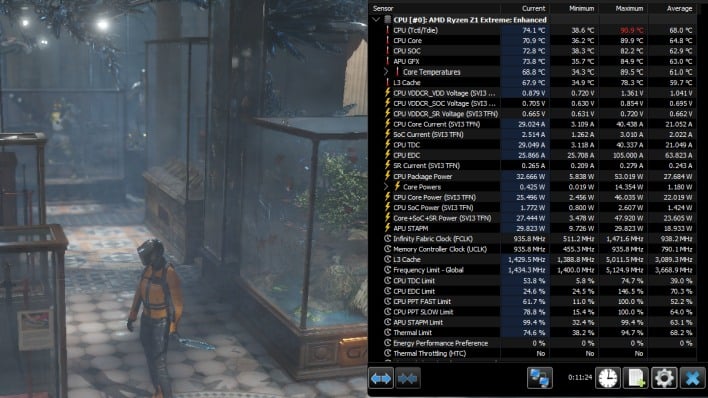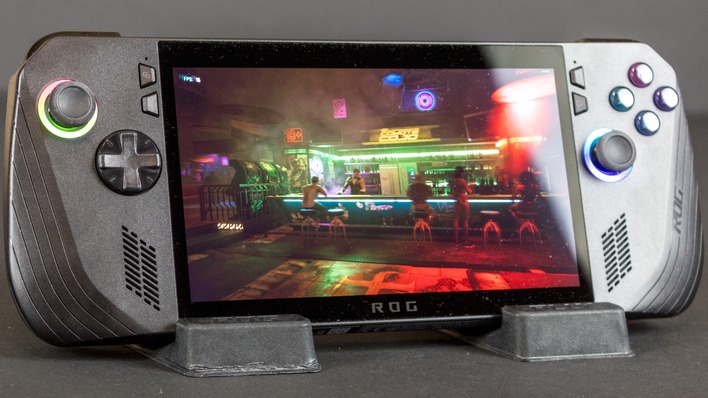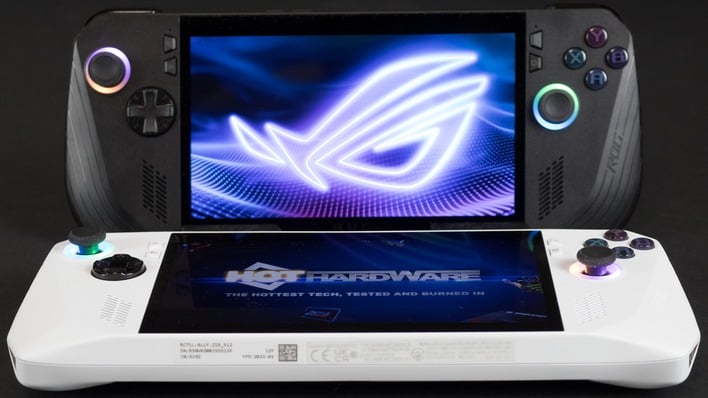ASUS ROG Ally X Review: Handheld PC Gaming Greatness
ASUS ROG Ally X Thermals and Acoustics
This section is going to be relatively short because there's not really much to say. Much like the original ROG Ally, the Ally X is inaudible in essentially all cases. Unless you're sitting in an anechoic chamber, you're not going to be bothered by fan noise from this device. That's partially because it's so quiet overall, and partially because ASUS barely ramps up the fans on the default profiles.This is a screenshot of a looping 3DMark Time Spy benchmark, with a simultaneous readout from HWiNFO. As you can see, at no point during the looping stress test did we see thermal throttling. The temperature did get a little spicy at just over 90°C, but the throttle temperature on the Ryzen Z1 Extreme is 100°C, so we're still good. While the back of the system does get warm in these conditions, the handgrips stay very comfortable.
The only way you're going to get this machine this hot is by having it plugged in and running in Turbo mode. Lower power limits means less heat output, and so anytime you're gaming in handheld mode, given that you're likely to be in Silent or Performance mode for better battery life, you're absolutely not going to overheat the system. To sum up: unlikely to throttle in Turbo, almost impossible in Performance or Silent modes. Thermals and acoustics are total non issue with the ROG Ally X.
ASUS ROG Ally X Battery Life
Here's where we see the biggest area of improvement from the original Ally to the new recipe. Make no mistake: we liked the original Ally, but its battery life wasn't great, and it was a common pain point on an otherwise quite excellent handheld. We already told you that ASUS doubled the size of the battery on the Ally X, but the manufacturer clearly did much more than just that.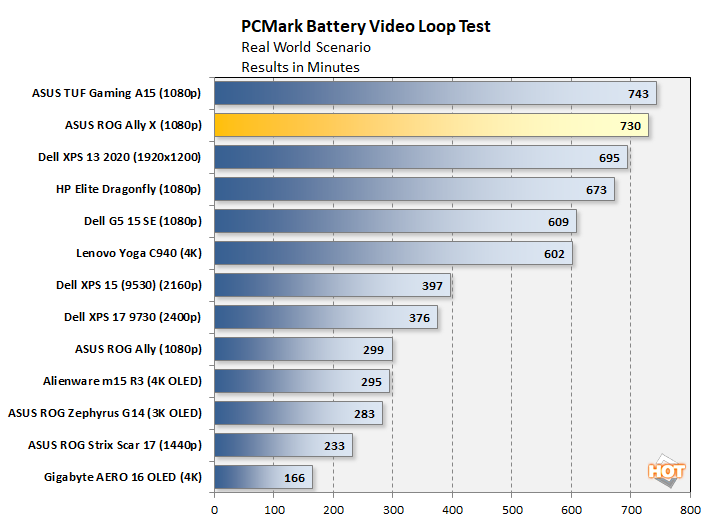
You're probably not buying an Ally X to watch videos on it, and we get that. However, in this comparison, this gaming handheld is beating out numerous thin and light laptops specifically optimized for long battery life. It's actually kind of insane how long the battery on this thing lasts. This result is 2.4x the result of the original Ally, far better than just the larger battery would indicate.
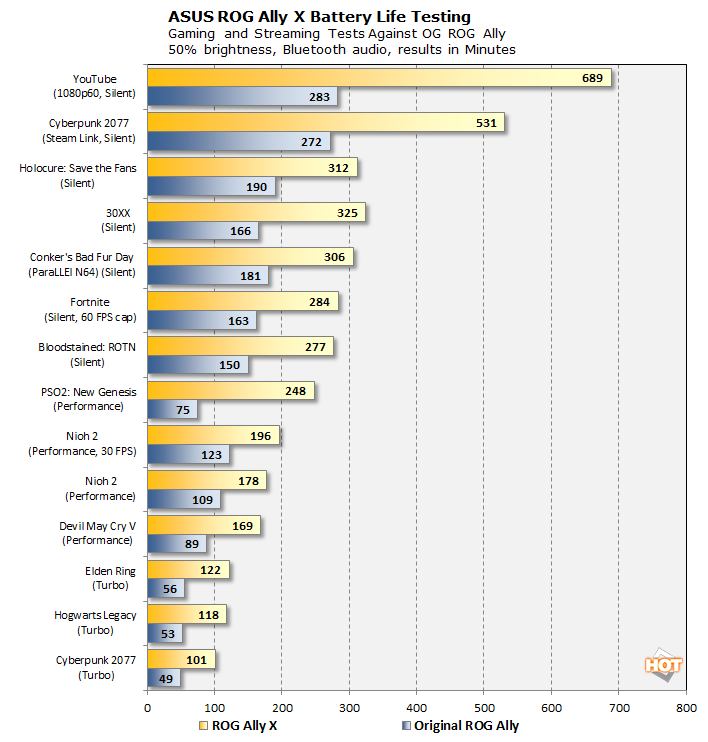
We also revisited the battery tests that we performed with the original Ally. The scale of this chart is thrown off by the two results at the top which are essentially video playback tests, one from YouTube, and one using Steam Link in-home streaming (which works great on the Ally, by the way.)
Below that, we have some results from games in Silent mode, some results from games in Performance mode, and a few results from games in Turbo mode. The worst-case battery life is still only 101 minutes, which is not particularly long, but that's while playing an incredibly-demanding game that slams both CPU and GPU as hard as it can. The result is still over double that of the original Ally.
Standouts from this testing are the PSO2 New Genesis result and the Elden Ring result. PSO2: New Genesis ran very poorly on RDNA 3 the last time we tested it, giving us our lowest result in the Performance section. It runs much better now, as you can see.
Meanwhile, despite that we put Elden Ring in the "Performance" category this time around, we tested FromSoftware's epic on Turbo for battery life because that was the way we tested it on the original Ally. While the first-gen machine struggled to hit an hour, the Ally X exceeded two hours, which is probably more than enough Elden Ring to be playing in a single sitting—got to manage your blood pressure, after all.
A key point is that not only did we get to play for more than twice as long, but we also had an overall better experience while doing so, which is true of many of the results here. Because ASUS adjusted the power profiles upward (i.e. "Silent" went from 9W to 13W), you not only get longer battery life, but a more enjoyable play experience, too.
ASUS ROG Ally X Gaming Handheld: Pricing & Our Thoughts
What we think of the ASUS ROG Ally X is probably quite clear by this point, but in case you haven't figured it out (or you skipped to the conclusion, naughty reader), we'll say it plainly. The ROG Ally X addresses nearly every single shortcoming of the original machine in grand fashion. If you were on the fence about the original Ally, then this machine will probably be exactly what you were waiting for.The machine's extra memory with a higher transfer rate makes more games playable in native 1080p at 60 FPS. A second USB Type-C port allows for easy charging while also using external storage or wired networking. Improvements to the screen increase both maximum and minimum brightness. Optimizations to the controls make it more comfortable to use, and a reworked internal layout resolves some of the issues that affected the original device.
If you don't have a gaming handheld yet, and you are keen to get one, the ROG Ally X is one of the best options on the market currently. Versus its competitors, you get full Windows' software compatibility, long battery life, a native-landscape VRR screen, plenty of RAM, and a solid balance between performance and efficiency. There's very little to complain about here, aside from our frustrations with the way ASUS and AMD are handling graphics driver updates.
Ultimately, we can't tell you whether the extra investment is worth it, because it's going to depend a lot on how you use the hardware. In a way, the Ally X and Steam Deck serve somewhat different niches. If you are primarily keen on indie games and emulation of older systems, then the Steam Deck might be a better choice. However, if you want the flexibility of a full Windows experience, and the horsepower to handle modern AAA games and PS3 emulation, then the ASUS ROG Ally X is for you.


